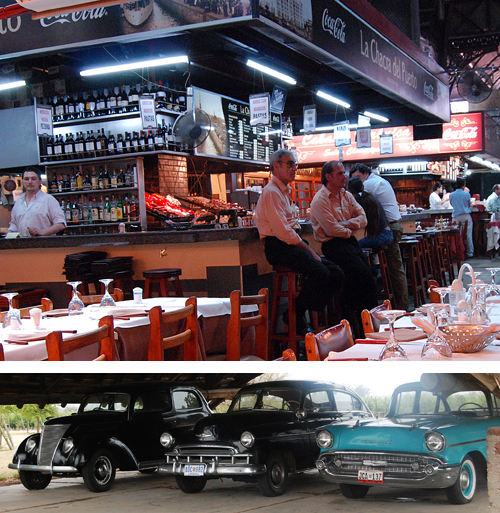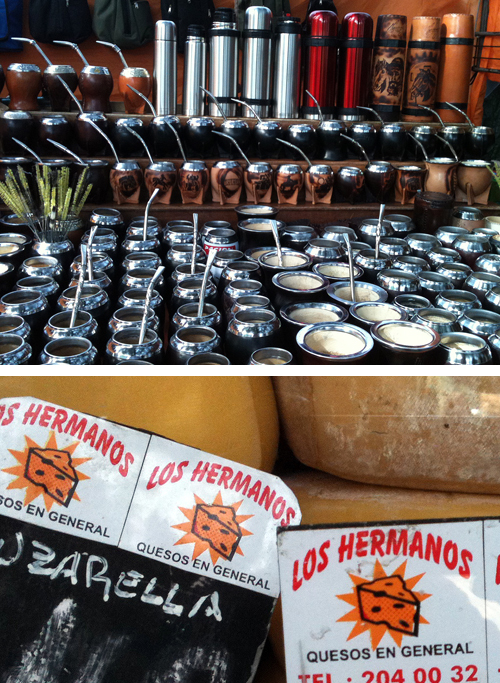These days, Uruguay seems to be on everyone’s lips. Last weekend The Wall Street Journal declared Colonia and Carmelo a “great escape”. Celebrity Chef Bobby Flay also took refuge from the harsh northern winter in Uruguay during their summer season. What is it about the place? It’s decidedly under-the-radar, a rural bucolic country, not unlike Switzerland where cows outnumber people 4 to 1. The country´s low key, laid back vibe is a breath of fresh air.
So in all the press hoopla over Carmelo, Colonia, and the ever glitzy Punta del Este, what about the capital, Montevideo?
Situated on the ocean-like Río de la Plata, Montevideo is the southernmost capital in South America and home to nearly 1.5 million habitants, over 50% of the country’s total population. Founded as a port in 1726 by Bruno Mauricio de Zabala as a strategic move amidst the Spanish-Portuguese dispute over the platine region, the bay was an ideal natural port for cargo.
So what’s Montevideo’s vibe? I personally feel it’s undervalued and overshadowed to a certain extent by nearby Buenos Aires. Or, everybody heads for the beaches and glazes over this fascinating city. First of all, it is NOT a smaller version of BA. The city has its own unique personality, history and feel. Since it’s the cultural cradle of Uruguay, in my humble opinion, it merits at least a couple days of exploration into its charismatic neighborhoods, especially if you want to unpeel some layers of Uruguayan culture.
That means going deeper than the immediate area around port and the Old City. Go for a walk at sunset along the rambla on the River in the afternoon. Sit down to sip a mate and take some time to savor the present momento, as Uruguayan’s so often do. Wander through the tree-lined streets in shady neighborhoods like Pocitos. Go shopping for antiques on the weekend in huge junk markets like Tristán Navaja. It’s a city, for me at least, that smells of burning Wood and seared meat. A slight ocean scent on days when the River is brackish and more salty. It’s got a slow beat and lifestyle that grows on you, if you let yourself go and just be.
Let’s go on a brief tour of Montevideo’s barrios.

La Rambla
La Rambla refers to the stretch of coastal highway that snakes along the beaches of Montevideo from Carrasco down to the port. The road covers over 22 kilometers and its name changes several times as one travels it: Rambla Sur, Rambla Franklin D. Roosevelt, Rambla Armenia, and many others. This grand ocean road is scenic, intrinsic to understanding this port city and country whose population predominantly resides along the coast. La Rambla passes popular sandy white beaches like Pocitos in the city, to open water and sand in the posh neighborhood of Carrasco. There are cafés, restaurants, marinas, yachts, fishing spots, and many benches to take in the coast and watch the fabulous sunsets — with a ubiquitous, mate tea.
Ciudad Vieja (Old City)
Only a few years ago, this colonial, central area of the city was almost totally abandoned. However the alcalde, mayor, saw the opportunity to revamp the center and today the Ciudad Vieja is an emerging neighborhood. Gourmet restaurants feature young chefs and owners, like La Pasionaria. Art galleries and museums, boutiques, and even new hotels are coming back to the area. Old City is, in essence, a bit of a time warp to another era in the early 1900s when the Río de la Plata was living a heyday.
Begin your exploration in the must-eat destination of the Mercado del Puerto at classics like El Palenque with all artisan-sourced ingredients. Here, meat in all its glorious forms (steak, innards, sausage, morcilla, lamb, pork, prosciutto) is the order of the day. Want to eat like a local? Order a juicy bife ancho rare and top it with the addictive salsa criolla. For those eating, literally, everything, try the mixed parrilla, with a little bite of all things delicious including the sweet blood sauage, a local delicacy.
After that big lunch, you need to walk. Stroll along the pedestrian walkway, Paseo Sarandí, which will take you through the heart of this neighborhood. A bustle of activity in the week, look up to admire some of Uruguay’s most beautiful colonial buildings. Stop off in the Plaza de la Constitución with the imposing Metropolitan Cathedral across the plaza. On Saturdays, there’s a colorful street market hawking everything from mate gourds to local art. If you haven’t tried the chivito, Uruguay’s most famous triple-decker sandwich, stop by the Montevideo institution La Pasiva on the corner of J. Carlos Goméz. Continue past the cabildo, old town hall, which has a museum dedicated to municipal history and the storing of the municipal archives. If you’re a modern art lover, make time to visit the Joaquín Torres García museum, one of Uruguay’s best known artists, who is known as the founder of constructive universalism in the early 1900s.
Most impressive is the Puerta de la Ciudadela, literally meaning Citadel Door, the gateway to the Plaza Independencia, one of the many large, open spaces in the city. Be sure to catch a show at the Solis Theater, Uruguay´s oldest theater built in 1856 or take a tour of the space. With stately columns that are distinctly European, it’s just undergone a restoration.
Don’t miss some of the nightlife and cafés that make this area a classic. Tango the night away at spots like Bar Fun Fun with the locals, or eat up a fainá at classic pizzerias like Bar Tasende off of Ciudadela. The old world charm, architecture, and beat are truly a micro sample of Uruguay’s history, which is inevitably moving into the future.
For those of you wanting to go deeper into Montevideo’s history, I recommend taking a historical tour of the city and visiting the old neighborhood of El Prado, located along Millán Avenue, with gorgeous parks and stately mansions. A good excuse to head there is the restaurant named Malandrino, a gourmet restaurant started by Pablo Botta. Try the lamb wrapped in phyllo dough filled with arugula and Camembert roasted in the oven till crisp with homemade gnocchi. With a hearty Tannat like Amat from classic wineries like Carrau, you cannot go wrong in this historical corner.
Palermo
Until the early twentieth century, Italian immigrants arrived in droves to settle the farmlands of Uruguay. Palermo, which takes its name from the same Sicilian city in Italy, is where most of these people began their new lives. Now, the area is known as the most bohemian and artistic in Montevideo.
To really understand the culture and history of this area, you must first understand the term Candombe. This word refers to the Afro-Uruguayan rhythm music that permeates the area, day and night and particularly during carnival. In the eighteenth century, the Port of Montevideo received many slaves from Africa. After freedom was granted there were large, public celebrations where the freed slaves shared some of their traditional music and dance from their homeland. These are the roots of contemporary Candombe. Today you can witness the Candombe predominantly during carnival, the longest in South America, where drum groups practice for the Desfile de llamadas, where a small group of drummers “call” other drummers to join them with their music and beats.
Walk along Calle Carlos Gardel (named after the great Tango master) that originates from the Rambla Sur. It feels like you are walking in the nineteenth century. Alongside the huge houses stand colorful murals celebrating the drum history in the area.
Our barrio adventure continues tomorrow, with Part II.














